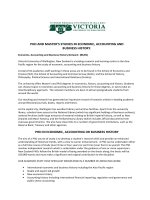- Trang chủ >>
- Đại cương >>
- Kinh tế vĩ mô
managing mobile services technologies and business practices
Bạn đang xem bản rút gọn của tài liệu. Xem và tải ngay bản đầy đủ của tài liệu tại đây (3.14 MB, 274 trang )
P1: FCG
WY059-FM.tex WY059-Raisanen.cls December 1, 2004 17:53
Managing Mobile Services
Technologies and Business Practices
Ulla Koivukoski and Vilho R
¨
ais
¨
anen
Nokia Networks & TeleManagement Forum, Finland
iii
P1: FCG
WY059-FM.tex WY059-Raisanen.cls December 1, 2004 17:53
ii
P1: FCG
WY059-FM.tex WY059-Raisanen.cls December 1, 2004 17:53
Managing Mobile Services
i
P1: FCG
WY059-FM.tex WY059-Raisanen.cls December 1, 2004 17:53
ii
P1: FCG
WY059-FM.tex WY059-Raisanen.cls December 1, 2004 17:53
Managing Mobile Services
Technologies and Business Practices
Ulla Koivukoski and Vilho R
¨
ais
¨
anen
Nokia Networks & TeleManagement Forum, Finland
iii
P1: FCG
WY059-FM.tex WY059-Raisanen.cls December 1, 2004 17:53
Copyright
C
2005 John Wiley & Sons Ltd, The Atrium, Southern Gate, Chichester,
West Sussex PO19 8SQ, England
Telephone (+44) 1243 779777
Email (for orders and customer service enquiries):
Visit our Home Page on www.wileyeurope.com or www.wiley.com
All Rights Reserved. No part of this publication may be reproduced, stored in a retrieval
system or transmitted in any form or by any means, electronic, mechanical, photocopying,
recording, scanning or otherwise, except under the terms of the Copyright, Designs and
Patents Act 1988 or under the terms of a licence issued by the Copyright Licensing Agency
Ltd, 90 Tottenham Court Road, London W1T 4LP, UK, without the permission in writing of
the Publisher. Requests to the Publisher should be addressed to the Permissions
Department, John Wiley & Sons Ltd, The Atrium, Southern Gate, Chichester, West Sussex
PO19 8SQ, England, or emailed to , or faxed to (+44) 1243 770620.
This publication is designed to provide accurate and authoritative information in regard to
the subject matter covered. It is sold on the understanding that the Publisher is not engaged
in rendering professional services. If professional advice or other expert assistance is
required, the services of a competent professional should be sought.
Other Wiley Editorial Offices
John Wiley & Sons Inc., 111 River Street, Hoboken, NJ 07030, USA
Jossey-Bass, 989 Market Street, San Francisco, CA 94103-1741, USA
Wiley-VCH Verlag GmbH, Boschstr. 12, D-69469 Weinheim, Germany
John Wiley & Sons Australia Ltd, 33 Park Road, Milton, Queensland 4064, Australia
John Wiley & Sons (Asia) Pte Ltd, 2 Clementi Loop #02-01, Jin Xing Distripark,
Singapore 129809
John Wiley & Sons Canada Ltd, 22 Worcester Road, Etobicoke, Ontario, Canada M9W 1L1
Wiley also publishes its books in a variety of electronic formats. Some content that appears in
print may not be available in electronic books.
Library of Congress Cataloging-in-Publication Data
Koivukoski, Ulla.
Managing mobile services : technologies and business practices / Ulla
Koivukoski and Vilho R
¨
ais
¨
anen.
p. cm.
Includes bibliographical references and index.
ISBN 0-470-02144-6
1. Mobile communication systems—Management. I. R
¨
ais
¨
anen, Vilho. II. Title.
TK6570.M6K65 2005
384.5
3
068—dc22 2004027088
British Library Cataloguing in Publication Data
A catalogue record for this book is available from the British Library
ISBN 0-470-02144-6
Typeset in 11/13pt Palatino by TechBooks, Delhi, India
Printed and bound in Germany
This book is printed on acid-free paper responsibly manufactured from sustainable
forestry in which at least two trees are planted for each one used for paper production.
iv
P1: FCG
WY059-FM.tex WY059-Raisanen.cls December 1, 2004 17:53
Contents
About the editors xi
Contributors xiii
Foreword xvii
About the book xxi
Organization xxii
Interdependencies between chapters xxiii
Acknowledgements xxv
Abbreviations xxvii
1 Introduction 1
Ulla Koivukoski
1.1 Introduction to managing mobile services 1
1.2 The business environment 5
1.3 Business requirements 7
1.3.1 The end-user perspective 7
1.3.2 The network operator and service
provider perspective 8
1.4 The shifting focus of service management 10
1.5 End-user driven service development and optimization 11
1.5.1 From customer requirements to
service development 11
1.5.2 From customer experience to service optimization 13
1.6 Re-shaping the positioning of BSS and OSS 14
1.7 Ways to capture market opportunity 15
1.8 References 16
Managing Mobile Services U. Koivukoski, V. R
¨
ais
¨
anen
C
2005 John Wiley & Sons, Ltd ISBN: 0-470-02144-6
P1: FCG
WY059-FM.tex WY059-Raisanen.cls December 1, 2004 17:53
vi CONTENTS
2 Business Evolution of Mobile Services 17
Sonja Hilavuo
2.1 Introduction 17
2.2 Mobile services evolution 18
2.2.1 Voice and other calls 21
2.2.2 Person-to-person messaging 22
2.2.3 Content services 23
2.2.4 Transaction services 26
2.2.5 Business data services 27
2.2.6 Advertising 28
2.3 Value chain evolution 29
2.3.1 Customers 29
2.3.2 Mobile operators 32
2.3.3 Service, content and
application providers 34
2.4 Business model evolution 37
2.5 Conclusion 44
3 Focus Topic 1 – The Tune2Radio Service 47
Ulla Koivukoski
3.1 Introduction 47
3.2 The business environment encouraging
service development 49
3.3 Business model 50
3.4 Value for the end-user 52
3.5 Technical implementation 52
3.5.1 The roles of the players in implementation 52
3.5.2 Deployment 53
3.6 Learning 55
3.6.1 End-user perspective 55
3.6.2 Technology perspective 56
3.6.3 Business perspective 57
4 Service Management 59
Elena Lialiamou, Mikko Ruhanen and Pertti Pielismaa
4.1 Introduction 59
4.2 Service management processes 61
4.2.1 The service lifecycle 61
4.2.2 Operating roles in service management 63
4.2.3 Workflows and workflow management 65
4.3 Service management architectures 65
4.4 Requirements for service management 68
4.4.1 Implications of a multi-provider environment 68
4.4.2 Device management 69
4.4.3 Personalization and differentiation 72
4.4.4 Service convergence 73
4.4.5 Telecom – IT convergence 74
4.4.6 Inventory 74
P1: FCG
WY059-FM.tex WY059-Raisanen.cls December 1, 2004 17:53
CONTENTS vii
4.4.7 Multi-vendor environment 75
4.4.8 Conclusion 75
4.5 Service management for GSM networks 76
4.6 Service management for GPRS and mobile
data networks 79
4.7 Service management for 3G and multimedia 80
4.8 Reference 84
5 Standardization Related to Service Management 85
Margareta Bj
¨
orksten, P
´
eter Dornbach, Frederick Hirsch, Valtteri
Niemi, Pertti Pielismaa, Peeter Pruuden and Vilho R
¨
ais
¨
anen
5.1 Introduction 85
5.2 IETF 87
5.3 Service availability forum 88
5.4 3GPP 89
5.5 OMA 91
5.5.1 History 91
5.6 W3C, OASIS and WS-I 96
5.6.1 W3C 97
5.6.2 OASIS 99
5.6.3 WS-I 100
5.7 Liberty Alliance 101
5.7.1 History and organization 101
5.7.2 Liberty and network identity 102
5.7.3 The Liberty Specifications in detail 105
5.7.4 Implementation status 109
5.8 TMF 110
5.9 DMTF 115
5.10 OSS/J 115
5.11 Conclusion 117
5.12 References 118
6 Requirements and Characteristics of IP Services 121
Margareta Bj
¨
orksten, G
´
abor Marton, Zolt
´
an N
´
emeth,
Valtteri Niemi and Vilho R
¨
ais
¨
anen
6.1 Introduction 121
6.2 Crash course in mobile network technologies 128
6.3 Requirements of services 130
6.3.1 Service class 1: content service 131
6.3.2 Service class 2: augmented VoIP 133
6.3.3 Summary 136
6.4 Characteristics of services 146
6.4.1 Service class 1: content service 147
6.4.2 Service class 2: augmented VoIP 147
6.4.3 Summary 148
6.5 Implications for service and network
management 149
6.6 References 150
P1: FCG
WY059-FM.tex WY059-Raisanen.cls December 1, 2004 17:53
viii CONTENTS
7 Service Modelling 153
Margareta Bj
¨
orksten, G
´
abor Marton, Zolt
´
an N
´
emeth, Valtteri
Niemi, Pertti Pielismaa, Vilho R
¨
ais
¨
anen and Mikko Ruhanen
7.1 Introduction 153
7.1.1 Generic issues 154
7.1.2 User classification 155
7.1.3 Service provisioning in
wireless systems 156
7.1.4 Terminals 158
7.1.5 New service requirements 159
7.2 Requirements for service modelling 161
7.2.1 Business requirements 162
7.2.2 Technical requirements 164
7.3 Existing service models 168
7.3.1 Summary 176
7.4 Service model framework 177
7.5 Example: augmented VoIP 181
7.6 Conclusion 183
7.7 References 184
8 Focus Topic 2 – Service Control 189
Tuija Hurtta and Vilho R
¨
ais
¨
anen
8.1 Introduction 189
8.2 Main concepts 190
8.2.1 Services 190
8.2.2 Service flows 190
8.2.3 Access bearers 191
8.2.4 Rules 191
8.3 Business setting 191
8.3.1 Core network evolution –
intelligent edge 192
8.3.2 Connectivity 194
8.3.3 Service control 195
8.4 Service information 198
8.5 Service control procedures 199
8.5.1 Service control at the access
bearer establishment 200
8.5.2 Service control update 201
8.5.3 Service control at access bearer release 202
8.6 Key findings 203
9 Trends For The Future 205
Margareta Bj
¨
orksten, P
´
eter Dornbach, Sonja Hilavuo,
Frederick Hirsch, Tuija Hurtta, Ulla Koivukoski, Elena Lialiamou,
G
´
abor Marton, Zolt
´
an N
´
emeth, Valtteri Niemi, Peeter Pruuden,
Pertti Pielismaa, Vilho R
¨
ais
¨
anen and Mikko Ruhanen
9.1 Introduction 205
9.2 The end-user viewpoint 206
P1: FCG
WY059-FM.tex WY059-Raisanen.cls December 1, 2004 17:53
CONTENTS ix
9.3 The business viewpoint 208
9.4 The technology viewpoint 209
9.5 Conclusion 211
9.6 References 212
10 Summary 213
Ulla Koivukoski and Vilho R
¨
ais
¨
anen
Appendix: Service Framework Team Roles 217
Index 225
P1: FCG
WY059-FM.tex WY059-Raisanen.cls December 1, 2004 17:53
x
P1: FCG
WY059-FM.tex WY059-Raisanen.cls December 1, 2004 17:53
About the Editors
Ulla Koivukoski is the head of service management at Nokia
Networks and the team leader of Service Framework Team (SFT)
at TeleManagement Forum. She has been working in IT since 1984.
Ms Koivukoski has been involved in sales, marketing and business
management of the SW houses, and worked as a product manager
and head of product managementof UNIX, PC and communications
networks. As an independent consultant she has implemented sev-
eral Customer Relations Management (CRM) systems in medium-
sized and large Finnish companies, to keep customer information
updated both for long-term business planning and as a marketing
and sales tool. Ms Koivukoski has worked for Nokia since 1995 as a
marketing and business manager in network and service manage-
ment and broadband product units, as well as regional area organ-
isations. She has a BSc in natural science.
Dr Vilho R
¨
ais
¨
anen is Principal Engineer in Service Management
technologies at Operations Solutions, Nokia Networks. He is also
the editor of the guidebook by the SFT team of the Telemanagement
Forum. Dr R
¨
ais
¨
anen has contributed to IETF and ETSI standard-
ization, and lectured on the course ‘End-to-end IP service qual-
ity and mobility’ at the Department of Electrical Engineering at
Helsinki University of Technology during the spring term 2003. He
has three awarded patents. Dr R
¨
ais
¨
anen has a Doctor of Technology
degree from Helsinki University of Technology, and is the author of
Implementing Service Quality in IP Networks published in 2003 by
Managing Mobile Services U. Koivukoski, V. R
¨
ais
¨
anen
C
2005 John Wiley & Sons, Ltd ISBN: 0-470-02144-6
P1: FCG
WY059-FM.tex WY059-Raisanen.cls December 1, 2004 17:53
xii ABOUT THE EDITORS
John Wiley & Sons, Ltd., as well as over 20 peer-reviewed articles in
international journals in datacommunications and physics. He has
also acted as peer reviewer for three IEEE journals in the area of
service quality.
P1: FCG
WY059-FM.tex WY059-Raisanen.cls December 1, 2004 17:53
Contributors
Margareta Bj
¨
orksten
Nokia Research Centre, PO Box 407,
FIN-00045 Nokia Group, Finland.
P
´
eter Dornbach
Nokia Research Centre, K
¨
oztelek u. 6,
H-1092 Budapest, Hungary.
Sonja Hilavuo
Nokia Networks, PO Box 300,
FIN-00045 Nokia Group, Finland.
Frederick Hirsch
Nokia Technology Platforms,
5 Wayside Road, Burlington, MA 01803, USA.
Tuija Hurtta
Nokia Networks, PO Box 372,
FIN-00045 Nokia Group, Finland.
Managing Mobile Services U. Koivukoski, V. R
¨
ais
¨
anen
C
2005 John Wiley & Sons, Ltd ISBN: 0-470-02144-6
P1: FCG
WY059-FM.tex WY059-Raisanen.cls December 1, 2004 17:53
xiv CONTRIBUTORS
Ulla Koivukoski
Nokia Networks, PO Box 370,
FIN-00045 Nokia Group, Finland.
Elena Lialiamou
Intralot A.S., 64, Kifissias Ave. & 3,
Premetis Str., 151 25 Athens, Greece.
G
´
abor Marton
Nokia Research Centre, K
¨
oztelek u. 6,
H-1092 Budapest, Hungary.
Zolt
´
an N
´
emeth
Nokia Research Centre, K
¨
oztelek u. 6,
H-1092 Budapest, Hungary.
Valtteri Niemi
Nokia Research Centre, PO Box 407,
FIN-00045 Nokia Group, Finland.
Pertti Pielismaa
Nokia Networks, Hatanp
¨
a
¨
anvaltatie 30,
FIN-33100 Tampere, Finland.
Peeter Pruuden
Nokia Technology Platforms, PO, Box 321,
FIN-00045 Nokia Group, Finland.
Vilho R
¨
ais
¨
anen
Nokia Networks, PO Box 370,
FIN-00045 Nokia Group, Finland.
P1: FCG
WY059-FM.tex WY059-Raisanen.cls December 1, 2004 17:53
CONTRIBUTORS xv
Mikko Ruhanen
Nokia Networks, Hatanp
¨
a
¨
anvaltatie 30,
FIN-33100 Tampere, Finland.
P1: FCG
WY059-FM.tex WY059-Raisanen.cls December 1, 2004 17:53
xvi
P1: FCG
WY059-FM.tex WY059-Raisanen.cls December 1, 2004 17:53
Foreword
Pertti H
¨
oltt
¨
a, Elisa Corporation, Finland
A TELECOM OPERATOR’S AND SERVICE PROVIDER’S
VIEW ON SERVICE MANAGEMENT
During the past few years, telecom operators and service providers
(hereafter called operators) have faced remarkable challenges
caused by the fast changes in the technological, business, market
and regulatory environments. These changes have forced the op-
erators to rethink their business models, technology and service
platform infrastructures as well as their service offerings.
Due to regulatoryissues(network/service provider), cost-sharing
(MVNOs, Mobile Virtual Network Operators etc.) and interface
openness, traditional telecom business models have changed. Third
party service providers or Application Service Brokers (ASBs) are
entering the new wireless service market traditionally controlled by
telecom operators. This new chain of service production involves
several players and has an impact on business models as well as
operational issues.
One of the most important changes, from the technological point
of view, has been the infiltration of Internet technology, namely In-
ternet Protocol (IP), into almost all sectors of telecommunication. In-
ternet technology, when applied in professional operator-managed
telecommunication networks, is the major technical facilitator for
Managing Mobile Services U. Koivukoski, V. R
¨
ais
¨
anen
C
2005 John Wiley & Sons, Ltd ISBN: 0-470-02144-6
P1: FCG
WY059-FM.tex WY059-Raisanen.cls December 1, 2004 17:53
xviii FOREWORD
the convergence of fixed and mobile networks and new innovative
multi-channel (access independent) service offerings for different
applications and terminals. IP-based communication and applica-
tions together with digital content delivery will change the tradi-
tional telecom networks to scalablemultipurpose Service Networks.
The converging IP-based networks and the emergence of new
open application and service platforms will dramatically change
the traditional operator and service environment. The possibility
to rely on common network and service platform architectures for
both fixed and mobile networks offers the operators the possibility
to plan and deploy cost-effective, future-proof and multipurpose
infrastructure and service offerings for several customer segments.
In this open communication environment the importance of the ser-
vice management will be emphasized. Understanding new require-
ments for Operations Support Systems/Business Support Systems
(OSS/BSS) functions, their relation to the service environment and
overall service management process is very important for operator
business.
New operator-managed IP-based services will set difficult re-
quirements for service management and will call for close inter-
action between network management (e.g., resource management)
and service management layers and functions. The basic require-
ment will be the overall security at all levels and end-to-end. The
importance of the security will be emphasized along with the con-
vergence of fixed and mobile networks, open interfaces, diversity
of terminals, and the possibility to integrate services.
The security issues will be even more challenging to handle due
to the complexity of the service environment. Longer service pro-
duction chains also add the importance of service provisioning and
service assurance systems as part of the service management. New
intelligent charging and billing methods must also be developed
and managed within this multiplayer environment.
New multimedia IP services will also require that network and
service platforms support advanced Quality of Service (QoS) han-
dling and application and service specific QoS classes. From a ser-
vice management point of view there must be versatile end-to-end
QoS and Service Level Agreement (SLA) management features, es-
pecially in the case of wireless and mobile networks because of the
terminal and servicemobility and restrictedrecoursesof bandwidth.
The convergence of Telecommunication and Information Tech-
nology (IT) towards Information and Communication Technology
P1: FCG
WY059-FM.tex WY059-Raisanen.cls December 1, 2004 17:53
FOREWORD xix
(ICT) gives business customers added value for their IT solutions
with the integration of communication services like open interfaces
to contact centres, billing and payment services, authentication and
authorization services, location and presence services. IT and ICT
convergence brings OSS and BSS closer together, not only within the
operator systems, but also between the operator and the customer
systems. This leads to the requirement of getting information about
the customer’s business processes and mapping them to the oper-
ator’s OSS/BSS processes. Close interaction with service manage-
ment and Customer Relationship Management (CRM) is required
for efficient service and customer care.
Operators are switching from the technology and service-
centric approach to a user-centric paradigm which includes self-
provisioning, personalized and user-tailored solutions. The user-
centric viewshould alsocontain therole ofthe partnersin theservice
chain. This means that new business models have to be evaluated
and place the users and the partners in central position. This will
create new business roles and open Application Programming In-
terfaces (APIs). One good example is the increase of peer-to-peer
applications and services where the business models and service
management solutions are still in the early phase.
With mobility and in the future ambient intelligence and ubiqui-
tous computing environment, new service delivery methods will be
needed for context-aware services. These will include conditioned
action in response to context information and their mapping to user
profiles to provide an adaptive behaviour of services.
The user-centric approach, and the complexity of the heteroge-
neous network and service environment, will present a number of
operational challenges for the operators in enabling effective and
efficient service provisions and offerings. From the user’s point of
view, the key requirement will be the ability to access the services in
a seamless and technology-transparent way, with the ease of use of
terminals. Standardized service management tools, functions and
processes will help to meet these challenges.
P1: FCG
WY059-FM.tex WY059-Raisanen.cls December 1, 2004 17:53
xx
P1: FCG
WY059-FM.tex WY059-Raisanen.cls December 1, 2004 17:53
About the Book
This book was written based on the increasing need to obtain top-
ical information about implementing packet-based services in mo-
bile networks. General Packet Radio Service (GPRS) and Wideband
Code Division Multiple Access (WCDMA) networks provide good
basic tools for provisioning services for mobile users, but the busi-
ness environment has changed since the inception of the original
GPRS mobile network architecture. One of the central themes of
this book, the change has been apparent in service value chains. The
service provisioning capabilities of mobile networks are evolving to
keep up with business requirements, and new technologies such as
Wireless Local Area Networks (WLAN) are being incorporated into
mobile networks. Evolving and diversifying services bring an extra
dimension to the picture.
The above situation has manifold consequences. In a sense, the
provisioning of packet-based services moves closer to provision-
ing of Internet services in general. However, state-of-the-art mobile
networks currently provide capabilities surpassing those of the In-
ternet, including service quality support and charging. From the
viewpoint of a content service provider, the capabilities of individ-
ual networksand terminal types may vary. In anenvironment where
lean operations are required of different business parties, a proper
understanding of the business environment is imperative. Indeed,
business and technology can no longer be thought of as separate
subjects in service provision, but should be dealt with together.
Managing Mobile Services U. Koivukoski, V. R
¨
ais
¨
anen
C
2005 John Wiley & Sons, Ltd ISBN: 0-470-02144-6
P1: FCG
WY059-FM.tex WY059-Raisanen.cls December 1, 2004 17:53
xxii ABOUT THE BOOK
Conveying the current understanding of the subject is the purpose
of this book.
This book will be of use both for business and technical read-
ers. The different chapters generally fall on either side of the busi-
ness/technical fence, but an attempt has been made to make them
all readable for both audiences. Below, we have outlined the orga-
nization of the book and described the dependencies between the
chapters.
ORGANIZATION
Chapter 1 is an introduction to the topic, describing the overall
approach adopted in the book.
Chapter 2 discusses business aspects of service management, in-
cluding changing operator business environments and value
chain structures.
Chapter 3 introduces the first focus topic, providing a summary of
a real-life service creation project. It provides the background to
the enhanced service management techniques introduced later.
This chapter, like Chapters 1 and 2, deals with business aspects of
mobile services, but is also useful reading for advanced technical
experts and managers.
Chapter 4 discusses service management at a generic level from the
viewpoint of processes and technology.
Chapter 5 reviews standardization relevant to service management
and operations support systems such as TeleManagement Forum.
Also, relevant aspects of other standardization fora such as Third
Generation Partnership Project (3GPP), Open Mobile Alliance
(OMA), and Internet Engineering Task Force (IETF) are discussed.
Chapter 6 discusses the requirements and characteristics of different
kinds of packet-based services. It provides the reader with an
understanding of technical issues that relate to different kinds of
services. It also summarizes service support capabilities.
Chapter 7 discusses service modelling related issues. Having an
adequate model for services is crucial for being able to manage
increasingly complex networks with a large number of multi-
component services. A framework for service modelling is pre-
sented and put into the context of selected industry initiatives and









